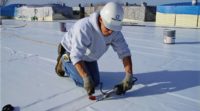The global food processing market is projected to reach $235.67 billion by 2028, up from $143.51 billion in 2020, as demand increases for fresh produce, meat and perishable packaged foods. The growth of this market is in turn fueling an increase in the construction of food processing facilities.
When it comes to the construction of food processing plants, versatile building materials are a must for meeting the unique specifications and requirements of these facilities.
Insulated metal panels (IMPs) are increasingly the preferred building envelope solution for these plants because of their versatility that includes thermal efficiency, temperature control, design flexibility, safety, ease of installation, durability and more.
Thermal efficiency
The thermal efficiency of IMPs makes them an ideal building envelope solution for thermally controlled environments like food processing facilities. IMPs have some of the highest insulating values per inch, allowing them to deliver the thermal efficiency required by food processing plants. With tight fitting panel joints and a full vapor and water barrier, this wall system is airtight, preventing thermal bridging and condensation.
Featuring a core of continuous, rigid insulation, IMPs achieve the R-values needed to ensure the stable interior environment food processing facilities need. Engineered for top-of-the-industry thermal performance, IMPs remain air and weathertight over the long term, helping to lower energy costs and overall operating costs in these facilities.
IMPs also meet increasingly stringent building code thermal performance requirements. While other insulations may have to use double layers or more expensive, higher density materials to meet thermal performance code requirements, IMPs are an all-in-one solution that easily meet these codes.
Temperature control
The thermal insulation capabilities of IMPs are another reason why they are increasingly being used in food processing and other facilities where temperature must be precisely controlled. Insulated panels are engineered to maintain a stable interior environment regardless of external weather conditions, ensuring that specific temperature and humidity level requirements are met to protect products from risk of spoilage or damage.
Panels from 2” to 6” thicknesses can be used in operating temperatures ranging from -40°F (-40°C) to 200°F (93°C).
Lower operational carbon emissions
Today, all industries including the food processing sector are factoring in carbon emissions when constructing new facilities.
IMPs can play a role in helping food processing companies achieve their decarbonization targets by providing airtight, moisture-resistant and continuous insulation. The high R-values and thermal performance delivered by IMPs results in improved energy efficiency, which lowers energy costs and greenhouse gas (GHG) emissions, all of which play a valuable role in achieving net-zero energy and low carbon targets. With insulation that meets energy efficiency code requirements, insulated panels can also help building projects earn LEED certification in the U.S. Green Building Council’s green building rating system.
IMPs typically have a 30–40-year lifespan and are designed for reuse after that. The steel in the panels can be recycled and the foam can be repurposed, both pre- and post-consumer. These features can help reduce a cold storage facility’s overall environmental impact with less embodied carbon than other wall assemblies.
One example of a food processing plant using IMPs is the Dairy Farmers of America (DFA) milk powder plant in Garden City, Kansas. This plant was built using more than 344,000 square feet of IMPs.
These panels contribute to the sustainability mission of this project by reducing thermal bridging and providing continuous insulation, which dramatically reduces heating or cooling loss and helps curb energy consumption.
The efforts incorporated into this state-of-the-art DFA plant led to Food Engineering magazine naming it the Sustainable Plant of the Year.
Design flexibility
The design flexibility of IMPs allows architects to move away from the typical uniform, boxy design of large-scale buildings like food processing plants.
Available in a wide range of finishes and colors that can conform to any brand design aesthetic, IMPs offer many design possibilities. These panels come in a range of panel lengths, widths, core thicknesses and can be installed vertically or horizontally. With IMPs, building and design professionals do not have to sacrifice style for durability, practicality and performance. Taking advantage of this flexibility, building and design professionals are increasingly using IMPs on food processing facilities to give these buildings a modern look and help companies highlight their brand.
Safety
The protection of food safety and quality can be built into food processing buildings, not only in how the structure is designed, but also through the building materials that are used to construct the facility.
Insulated wall panels designed for food processing facilities are offered in smooth surfaces that can be finished with a USDA-accepted coating. Easy to clean, these panels can withstand the heavy sanitization used in many food processing plants and other cold storage facilities. Their tight-fitting interlocking joints resist moisture and lower the risk of mold or bacterial growth.
IMPs can also help keep building occupants safe. Panels that are GREENGUARD Gold certified are third-party verified that they are not harmful to building occupants and do not adversely impact indoor environment quality.
Ease of installation
IMPs don’t only meet food processing safety and hygiene regulations and requirements; their ease of installation also helps meet construction timelines.
IMP assemblies are quicker to install than traditional site-built wall and roof enclosure systems. Requiring only one subcontractor instead of multiple trades to attach to the structural framing, IMPs provide a weathertight building envelope in a fraction of the time of other systems.
According to the Metal Construction Association’s (MCA’s) Selection Guideline for Insulated Metal Panels, IMPs can be erected at a rate of up to 5,000 square feet per eight-hour shift by a four-man crew on an industrial project, and up to 1,100 square feet per eight-hour shift by a four-man crew on an architectural project.
Accelerating speed of build with IMPs can create construction efficiencies that result in labor cost savings, faster dry-in of a project so inside finish work can begin sooner, and shorter project schedules.
Durability
IMPs can also stand up to the wear and tear of food processing plants. These panels are easy to clean and durable enough to withstand the heavy sanitization processes used in food processing plants without any damage to the panel.
Designed to last for decades with minimal upkeep, these panels require less maintenance than other exterior wall systems. They remain both air and weathertight and provide consistent high thermal performance over the long term.
Versatile IMPs combine thermal efficiency, temperature control, sustainability, design flexibility, safety, ease of installation, and durability to make them a strong building material choice for food processing facilities.



